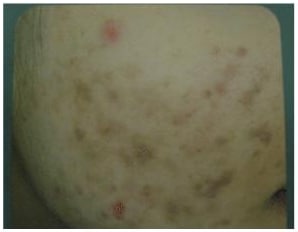Acne Scar Treatment
Solihull Medical Cosmetic Clinic, led by Dr Sagoo, is one of the very few leading acne scar treatment clinics in the UK to offer a full range of scar treatments and receives referrals from GPs as well as private hospitals.
What is acne scarring?
Acne scarring is a reaction to the inflammation in the skin caused by acne. During the inflammatory process, the tissue is destroyed. As the body attempts to heal the skin, a reaction called fibrosis occurs. Fibrosis leads to changes in the texture of the skin that can make it thinner (called atrophic) or thicker (called hypertrophic) than normal skin. Scarring is permanent. Thus, Acne scar treatment early, before scar formation and discolouration, is crucial.
Types of acne scarring
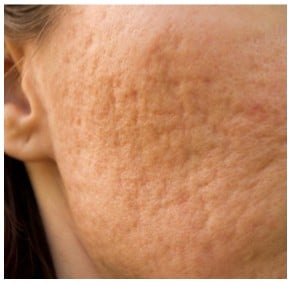
1.Rolling Scar
These are distensible, depressed scars with gently sloping edges. The rolling scar is shallow depressions that are best appreciated with a change in surface lighting. They can vary in size and often coalesce with neighbouring rolling scars. Rolling scars are shallow, wide (more than 4 to 5 mm) and have a subdermal
fibrous tether. These scars are caused by damage under the surface of the skin. They give the skin a wave-like appearance
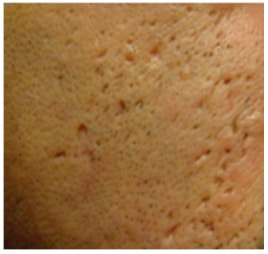
2. Ice Pick scar
Ice pick scars are narrow (less than 2 mm), deep sharply marinated epithelial tracts that extend vertically to the deep dermis or subcutaneous tissue. The skin looks as if it has been pierced by an ice pick or sharp instrument. Ice picks scars seem to make a small, deep, “hole” in the skin. They are the most common acne scars that occur on the cheeks and have a “punctate” appearance. Ice pick scars develop after an infection from a cyst or other deep inflamed skin tissue and its way to the surface leaving a long column-like
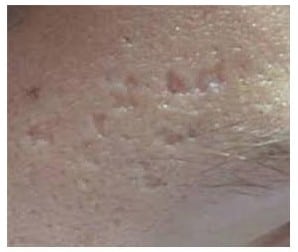
3.Box Scar
Boxcar scars are angular scars with sharp vertical edges and resemble the scars left by chickenpox. They may be shallow or deep, punched out, wide at the surface and at the base are most often found on the cheeks and temples.
4.Post Inflammatory pigmentation scarring (common in Asian and dark skin )
Post-inflammatory hyperpigmentation, or PIH, is the medical term used to describe discolouration of the skin that follows an inflammatory wound. It is the skin's natural response to inflammation.
PIH usually looks like a flat area of discolouration on the skin. It can range in colour from white, pink to red, purple, brown, or black, depending on your skin tone and depth of the discolouration.
PIH develops when a wound or irritation, like a scrape, rash, or pimple, causes the skin to become inflamed. As the skin heals, it produces too much melanin. Melanin is the protein in the skin that gives the skin its colour. It's the excess melanin that darkens and discolours the skin.1 This discolouration remains even after the wound has completely healed.
It can develop in all skin types, but it tends to be more severe and longer-lasting for people with medium to dark complexions.
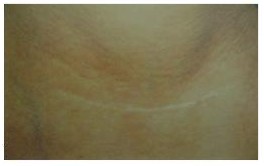
5.Post Inflammatory Hypopigmentation – white marks at the site of a healed acne
In darker skin individuals once acne has healed there can be loss of pigment to the surrounding skin area this is called hypopigmentation.
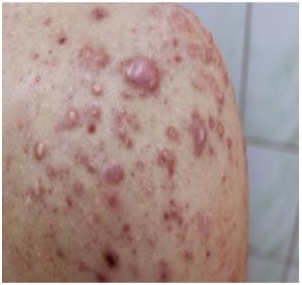
6.Keloid scarring
Keloids are a type of raised scar. They occur where the skin has healed after an injury. They can grow to be much larger than the original injury that caused the scar.
Anything that can cause a scar can cause a keloid. This includes being burned, cut, or having severe cystic acne.
Our Acne scar treatments
The Solihull Medical Cosmetic Clinic have 6 different world-class ablative and non-ablative lasers to treat every aspect of acne scarring making us one of the leading acne scarring clinics in UK. We see and treat several hundred acne scar patients every year from all over the UK and specialise in Asian skin as well. These treatments include:
- Topical therapy with creams and medication (for pigmented scars).
- Radiofrequency microneedling for (rolling and box scars and texture).
- TCA cross for( ice pick and narrow box scars).
- Medical grade subcision( Only carried out by Dr Sagoo).
- Hyaluronic acid Fillers ( for depressed rolling or box scars ) combined with a subcision.
- Punch excision ( for deep box or ice pick scars).
- Laser resurfacing C02 laser (to enhance texture and improve box and rolling scars).
- Laser acne redness reduction using medical intense pulsed light (for red scars).
- Laser genesis to improve pore size and texture of acne scarring.
- Steroid injection (to reduce keloid and inflamed acne scarring cysts).
- Plasma rich protein (PRP) to boost skin healing and skin regeneration.
Radiofrequency microneedling (Fractora)
What is FRACTORA and what does it do?
Fractora is the most advanced fractional radiofrequency (RF) treatment, which may provide anti-ageing improvements to skin tone and texture for a more radiant appearance, through ablation and skin resurfacing. Ablative treatments do remove some skin, so they have more downtime than other non-ablative technologies like IPL and FotoFacial.
Fractora delivers radiofrequency energy to the skin through an array of pins producing localized heat and causing small micro-lesion dots in the treatment area. The gentle heat generated by the Fractora pins in the sub-dermal tissue may promote collagen restructuring for skin rejuvenation and may produce an improved appearance in the skin. The methodical scattering of micro-lesions allows the skin to heal faster than if the entire area was ablated. What this means is that the majority of repair is being done under the skin, maximizing your results, but the damage to the surface is more minimal, allowing you to heal faster and better than with traditional resurfacing machines like Fraxel and CO2 technologies.
Fractora is designed to deliver targeted bipolar RF energy to various selectable depths in the skin. Fractora can meet or even exceed the results of fractional CO2 without the associated downtime, prolonged redness, and pigmentation drawbacks. Fractora may achieve full-scale treatment depths with customizable fractional energy, which may improve a variety of skin problems ranging from superficial skin tone problems to deep textural concerns acne scarring. Variable depths, densities and energy levels are used to give the possibility of results that were previously unattainable without excisional surgery.
This treatment delivers radiofrequency energy to the skin through several tiny pins which produce localized heat and small ‘micro-lesion’ dots in the treatment area, creating a healing response and increasing collagen production. It is very effective for darker skin types where laser treatment may not be advisable.
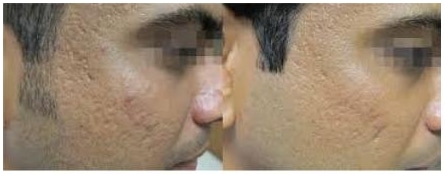
TCA CROSS technique:
The CROSS technique is used for ice-pick and narrow boxcar scars. A high-strength trichloroacetic acid (TCA) solution is placed in the base of these scars to ablate the epithelial wall and to promote dermal remodelling.
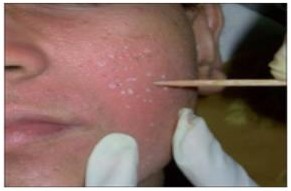
Medical grade subscision (By Dr Sagoo only)
Dr Sagoo is one of the very few doctors in the UK that carries out medical-grade subscision. This procedure is used for atrophic depressed scarring to cut and free up the strands which hold the scar down. Local anaesthesia is used and a needle is then inserted under the scar and gently moved underneath the skin, This helps to release the scar tissue and improve the appearance of the scar and stimulate new collagen production. Dr Sagoo is highly skilled in advanced subcision techniques to free scar tissue and has carried out hundreds of medical subscision procedures.
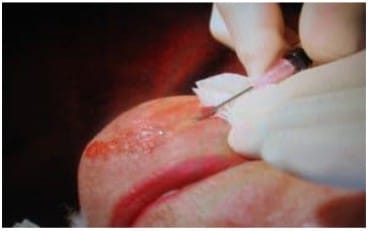
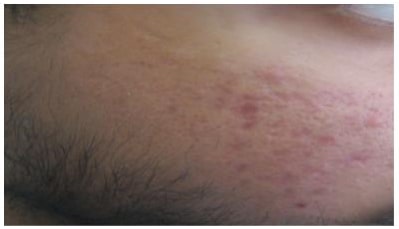
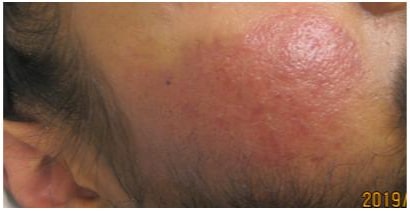
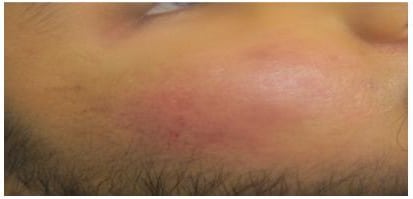
Fillers: Fillers add volume to the skin and are effective in treating patients with depressed soft rolling acne scars. They are not useful for icepick scars. They can be used alone or in combination with other procedures such as subscision.
3. Invasive
Punch excision technique:
The punch excision of icepick acne scars or deep boxcar scars is a technique that can be easily adopted into a dermatology practice. Most dermatologists are often performing punch biopsies for diagnostic purposes of inflammatory dermatoses. The same technique is used to remove appropriate acne scars. A disposable punch biopsy instrument is selected that matches the size of the icepick or narrow boxcar scar, including the walls of the scar.
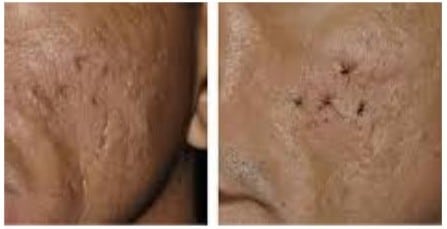
Laser resurfacing.
Laser resurfacing is a treatment to reduce facial wrinkles and skin irregularities, such as blemishes or acne scars.
The technique directs short, concentrated pulsating beams of light at irregular skin, precisely removing skin layer by layer. This popular procedure is also called lasabrasion, laser peel, or laser vaporization.
Solihull Medical Cosmetic Clinic is proud to be one of the few clinics in the UK to take delivery of one of the most powerful C02 lasers in the world… the Pixel laser which can ablate/remove layers of skin with minimal downtime but significantly boost collagen. This shall achieve even more considerable results for moderate and deep acne scarring alongside other combination treatments.
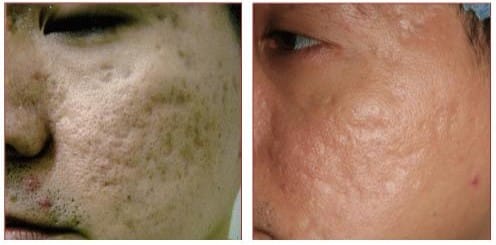
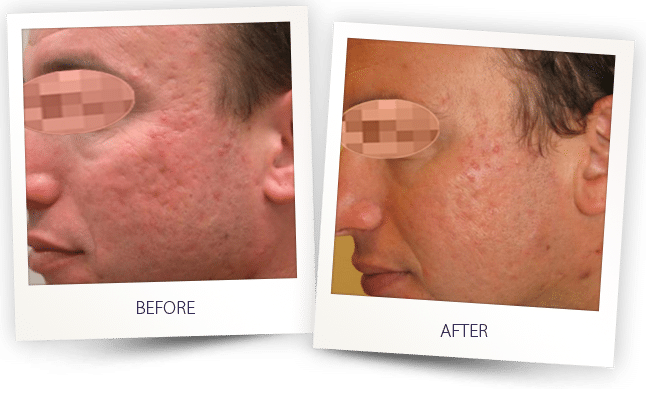

Through repeated acne flare-ups the skin and layers become inflamed over time leading to inflamed redness called erythema. Using non-invasive intense pulsed light and Nd Yag laser combination treatments we can reduce the redness which is quite common with inflammatory acne. Using laser genesis and Limelight foto facial not only improves redness but also improves skin texture complementing the other treatments available to treat scars.
Steroid injections for keloid acne scarring
Dr Sagoo may inject a corticosteroid solution directly into a hypertrophic scar or keloid, which may help reduce its size. ... In the hours after an injection, you can break up scar tissue yourself and improve the effectiveness of the injections by gently massaging the scar. Treatments are carried out 4-6 weeks apart which can significantly flatten scars before additional treatments are carried out.
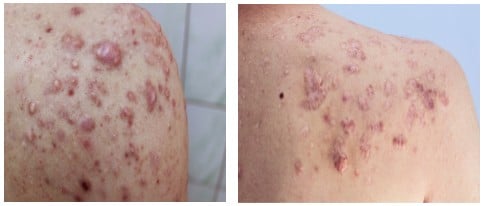
Dr Sagoo's combination treatments
Acne scarring is best addressed by combination treatments to achieve the best results. Dr Sagoo with decades of experience has a whole variety of different treatments that he will choose and tailor to the individual acne skin scarring. He may use one, two or 4 different treatments to achieve the overall improvement on the skin some in one session or course of sessions.
In addition to microneedling with platelet-rich plasma (PRP) and growth factors, Dr Sagoo utilizes Intense, a fractional radiofrequency (RF) microneedling device that uses micro-needles to deliver RF energy deep beneath the skin and stimulate long-term collagen production. Fractional, non-ablative lasers, such as the laser genesis provides light resurfacing of the skin, while the ablative CO2, or carbon dioxide laser, vaporizes the entire outer layer of the skin, achieving a thorough resurfacing and regenerating new cells. To further enhance these treatments, Dr Sagoo uses a YAG laser for skin rejuvenation; micro filler injections to aid in rebuilding tissue in the affected areas; IPL photo facial, which delivers intense pulsed light beneath the skin to reduce redness and improve skin tone and texture; and various peels, to enhance textural improvements and further stimulate collagen production.
With so many different combination treatments and years of experience of acne scarring, Solihull Medical Cosmetic Clinic is one of the leading clinics in the UK to offer a complete service.
Prices vary between £500 to £2000 per treatment which shall be discussed on close assessment.
To book a consultation and assessment of acne scarring please call us on 03300 417494.

